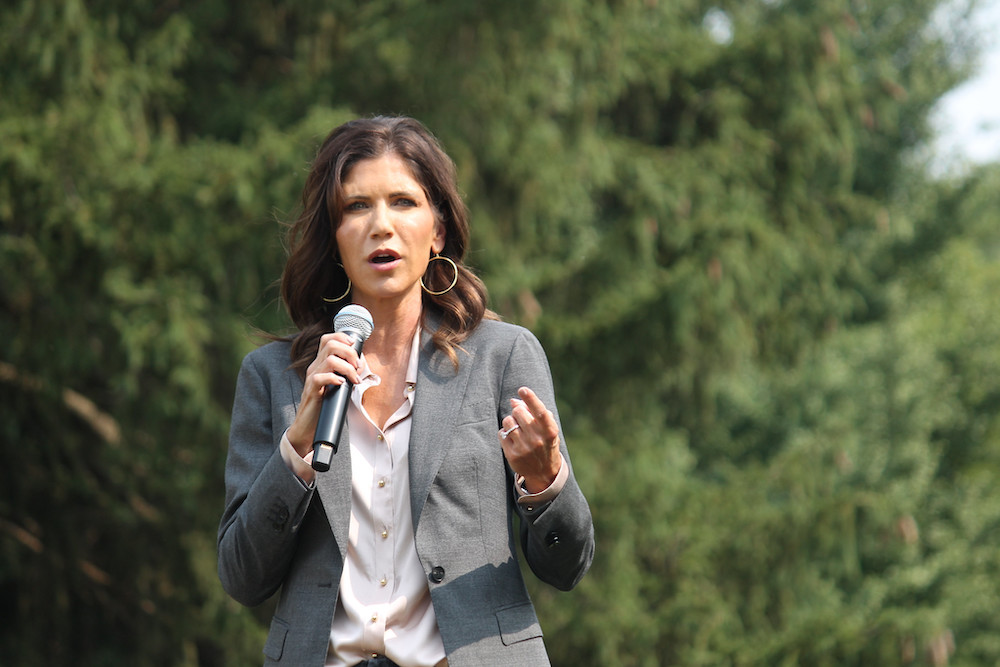
- Details
- By Brian Edwards
The Flandreau Santee Sioux Tribe lifted its banishment of South Dakota Gov. Kristi Noem this week, just days before her Friday confirmation hearing for the position of U.S. Secretary of Homeland Security.
Tribal President Anthony Reider informed Noem of the decision in a January 14 letter, writing she had fulfilled the tribe's conditions by addressing her previous statements about tribal members and their children.
The original ban came after Noem claimed at the state legislature that "cartels have a presence on several of South Dakota's tribal reservations" and later suggested tribal leaders were "personally benefiting" from cartels. She also drew criticism for saying Native children "don't have any hope" and "don't have parents who show up and help them." All nine tribal nations in South Dakota subsequently banned her from their lands.
Meanwhile in the state's capital, tribal leaders are pushing for improved state relations as Noem prepares to leave for her federal role. During Wednesday's State of the Tribes address, Sisseton Wahpeton Oyate Chairman J. Garrett Renville called for a "reset" with state leadership.
"Today, let's start to listen and actually hear," Renville told state lawmakers.
Standing Rock Chairwoman Janet Alkire expressed optimism about working with Lieutenant Governor Larry Rhoden, who will become governor if Noem is confirmed. Alkire said Rhoden has demonstrated openness to tribal collaboration, according to nonprofit newsroom South Dakota Searchlight.
In his comments, Renville presented key initiatives for state-tribal collaboration, from creating a permanent BIA law enforcement training facility to changing tax policies on tribal land purchases and reorganizing education oversight.
Noem's confirmation hearing is scheduled for Friday morning in Washington, D.C. If confirmed, she would oversee U.S. border security, immigration policy, and counter-terrorism efforts. Through a spokesman, she expressed appreciation for the Flandreau tribe's support of her nomination, according to a report by KELO in Sioux Falls.
As the incoming administration prepares for transition in the nation’s capital, the Flandreau tribe is also advancing national ambitions. Its joint venture with TransGas Development Systems LLC to build the Adams Fork Energy facility in West Virginia represents a major expansion into clean energy. The $3 billion project's six plants will produce 36,000 tons of ammonia daily when operations begin in 2027, meeting one-fifth of the U.S. Department of Energy's 2030 clean hydrogen goals, according to an April 2024 announcement.
More Stories Like This
Native News Weekly (August 25, 2024): D.C. BriefsUS Presidents in Their Own Words Concerning American Indians
Indigenous Actor Elaine Miles Reports Detention by Alleged ICE Agents
Happy Thanksgiving from Native News Online
Coming Up on Native Bidaské: Behind the Animation: Joey Clift Talks “Pow” and Native Storytelling
Help us tell the stories that could save Native languages and food traditions
At a critical moment for Indian Country, Native News Online is embarking on our most ambitious reporting project yet: "Cultivating Culture," a three-year investigation into two forces shaping Native community survival—food sovereignty and language revitalization.
The devastating impact of COVID-19 accelerated the loss of Native elders and with them, irreplaceable cultural knowledge. Yet across tribal communities, innovative leaders are fighting back, reclaiming traditional food systems and breathing new life into Native languages. These aren't just cultural preservation efforts—they're powerful pathways to community health, healing, and resilience.
Our dedicated reporting team will spend three years documenting these stories through on-the-ground reporting in 18 tribal communities, producing over 200 in-depth stories, 18 podcast episodes, and multimedia content that amplifies Indigenous voices. We'll show policymakers, funders, and allies how cultural restoration directly impacts physical and mental wellness while celebrating successful models of sovereignty and self-determination.
This isn't corporate media parachuting into Indian Country for a quick story. This is sustained, relationship-based journalism by Native reporters who understand these communities. It's "Warrior Journalism"—fearless reporting that serves the 5.5 million readers who depend on us for news that mainstream media often ignores.
We need your help right now. While we've secured partial funding, we're still $450,000 short of our three-year budget. Our immediate goal is $25,000 this month to keep this critical work moving forward—funding reporter salaries, travel to remote communities, photography, and the deep reporting these stories deserve.
Every dollar directly supports Indigenous journalists telling Indigenous stories. Whether it's $5 or $50, your contribution ensures these vital narratives of resilience, innovation, and hope don't disappear into silence.
 The stakes couldn't be higher. Native languages are being lost at an alarming rate. Food insecurity plagues many tribal communities. But solutions are emerging, and these stories need to be told.
The stakes couldn't be higher. Native languages are being lost at an alarming rate. Food insecurity plagues many tribal communities. But solutions are emerging, and these stories need to be told.
Support independent Native journalism. Fund the stories that matter.
Levi Rickert (Potawatomi), Editor & Publisher

